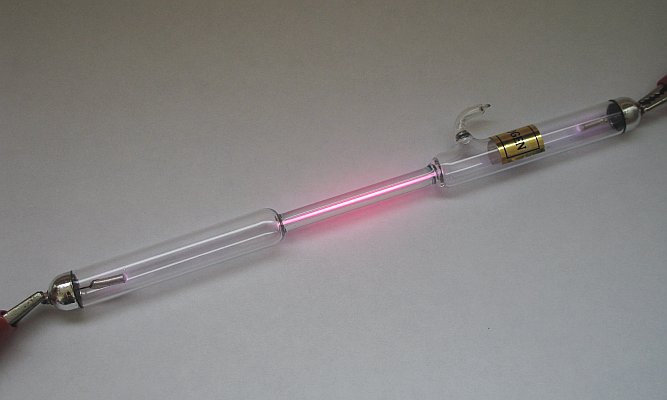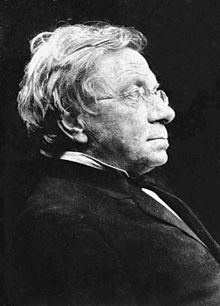What Color Of Light Is Emitted From A Hydrogen Atom That Changes From N = 6 To N = 2?
8.2: Atomic Spectra
- Page ID
- 24210
Learning Objectives
- To know the relationship between atomic spectra and the electronic structure of atoms.
The photoelectric effect provided indisputable testify for the existence of the photon and thus the particle-like behavior of electromagnetic radiation. The concept of the photon, however, emerged from experimentation with thermal radiation, electromagnetic radiations emitted every bit the result of a source's temperature, which produces a continuous spectrum of energies. More than straight evidence was needed to verify the quantized nature of electromagnetic radiation. In this department, we draw how experimentation with visible lite provided this evidence.
Line Spectra
Although objects at high temperature emit a continuous spectrum of electromagnetic radiation, a different kind of spectrum is observed when pure samples of individual elements are heated. For example, when a loftier-voltage electrical belch is passed through a sample of hydrogen gas at low pressure, the resulting private isolated hydrogen atoms caused by the dissociation of Htwo emit a red lite. Dissimilar blackbody radiation, the color of the light emitted by the hydrogen atoms does non depend greatly on the temperature of the gas in the tube. When the emitted calorie-free is passed through a prism, only a few narrow lines, chosen a line spectrum, which is a spectrum in which low-cal of only a sure wavelength is emitted or absorbed, rather than a continuous range of wavelengths (Figure \(\PageIndex{ane}\)), rather than a continuous range of colors. The lite emitted past hydrogen atoms is scarlet because, of its iv characteristic lines, the most intense line in its spectrum is in the scarlet portion of the visible spectrum, at 656 nm. With sodium, however, we detect a yellow color because the most intense lines in its spectrum are in the yellow portion of the spectrum, at about 589 nm.


Such emission spectra were observed for many other elements in the belatedly 19th century, which presented a major challenge because classical physics was unable to explicate them. Part of the explanation is provided by the ascertainment of only a few values of λ (or ν) in the line spectrum meant that only a few values of East were possible. Thus the energy levels of a hydrogen cantlet had to be quantized; in other words, only states that had sure values of energy were possible, or allowed. If a hydrogen atom could have whatsoever value of energy, and then a continuous spectrum would have been observed, like to blackbody radiation.
In 1885, a Swiss mathematics teacher, Johann Balmer (1825–1898), showed that the frequencies of the lines observed in the visible region of the spectrum of hydrogen fit a uncomplicated equation that can exist expressed as follows:
\[ u=constant\; \left ( \dfrac{one}{2^{2}}-\dfrac{i}{due north^{^{2}}} \right ) \label{\(\PageIndex{one}\)}\]
where n = 3, iv, 5, 6. As a issue, these lines are known every bit the Balmer series. The Swedish physicist Johannes Rydberg (1854–1919) subsequently restated and expanded Balmer's result in the Rydberg equation:
\[ \dfrac{1}{\lambda }=\Re\; \left ( \dfrac{1}{n^{2}_{i}}-\dfrac{1}{n^{2}_{two}} \right ) \label{\(\PageIndex{two}\)}\]
where \(n_1\) and \(n_2\) are positive integers, \(n_2 > n_1\), and \( \Re \) the Rydberg abiding, has a value of 1.09737 × 10vii m−ane.
Johann Balmer (1825–1898)
A mathematics teacher at a secondary school for girls in Switzerland, Balmer was threescore years old when he wrote the paper on the spectral lines of hydrogen that fabricated him famous.

Balmer published merely one other newspaper on the topic, which appeared when he was 72 years old.
Similar Balmer'south equation, Rydberg'due south simple equation described the wavelengths of the visible lines in the emission spectrum of hydrogen (with n 1 = 2, n 2 = iii, iv, five,…). More than important, Rydberg's equation also described the wavelengths of other serial of lines that would be observed in the emission spectrum of hydrogen: i in the ultraviolet (due north ane = 1, n ii = 2, iii, 4,…) and one in the infrared (due north 1 = 3, n 2 = iv, 5, 6). Unfortunately, scientists had non yet developed any theoretical justification for an equation of this form.
Summary
At that place is an intimate connection between the atomic structure of an atom and its spectral characteristics. Most light is polychromatic and contains low-cal of many wavelengths. Light that has just a single wavelength is monochromatic and is produced by devices called lasers, which use transitions between two diminutive energy levels to produce calorie-free in a very narrow range of wavelengths. Atoms can also absorb light of certain energies, resulting in a transition from the ground land or a lower-energy excited state to a higher-energy excited country. This produces an absorption spectrum, which has dark lines in the same position equally the bright lines in the emission spectrum of an element.
Atoms of individual elements emit light at only specific wavelengths, producing a line spectrum rather than the continuous spectrum of all wavelengths produced by a hot object. Niels Bohr explained the line spectrum of the hydrogen atom by assuming that the electron moved in circular orbits and that orbits with only certain radii were immune. Lines in the spectrum were due to transitions in which an electron moved from a higher-free energy orbit with a larger radius to a lower-energy orbit with smaller radius. The orbit closest to the nucleus represented the basis country of the atom and was most stable; orbits farther away were higher-energy excited states. Transitions from an excited country to a lower-energy state resulted in the emission of light with but a limited number of wavelengths. Bohr's model could non, still, explain the spectra of atoms heavier than hydrogen.
Source: https://chem.libretexts.org/Bookshelves/General_Chemistry/Map:_General_Chemistry_(Petrucci_et_al.)/08:_Electrons_in_Atoms/8.02:_Atomic_Spectra
Posted by: ballgairciand.blogspot.com


0 Response to "What Color Of Light Is Emitted From A Hydrogen Atom That Changes From N = 6 To N = 2?"
Post a Comment